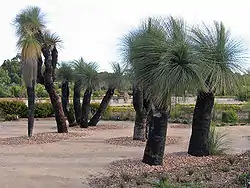Dasypogonaceae
Dasypogonaceae is a family of flowering plants based on the type genus Dasypogon, one that has traditionally not been commonly recognized by taxonomists; the plants it contains were usually included in the family Xanthorrhoeaceae. If valid, Dasypogonaceae includes four genera with 16 species.[1] The family is endemic to Australia. The best known representative is Kingia australis.
| Dasypogonaceae | |
|---|---|
 | |
| Kingia australis in the Royal Botanic Gardens, Cranbourne | |
| Scientific classification | |
| Kingdom: | Plantae |
| Clade: | Tracheophytes |
| Clade: | Angiosperms |
| Clade: | Monocots |
| Clade: | Commelinids |
| Order: | Arecales |
| Family: | Dasypogonaceae Dumort. |
| Genera | |
| |
The 2016 APG IV system places the family in the order Arecales, after several studies revealed the family as a sister-family to Arecaceae.[2] Other authors find that the placement of Dasypogonaceae remains undetermined, due to conflicting models, and leave it in an order of its own, the Dasypogonales.[3]
The earlier APG III (2009), APG II (2003), and the 1998 APG system all accepted the validity of the family, assigning it to the clade commelinids, but leaving it unplaced as to order.[4] The commelinids are monocots, the broad group to which, in any event, these plants clearly belong.
Phylogeny
Studies have confirmed the monophyletic character of the grouping.[5] The following is a phylogenetic tree of the family.[6]
| Dasypogonaceae |
| ||||||||||||||||||
References
- Christenhusz, M. J. M.; Byng, J. W. (2016). "The number of known plants species in the world and its annual increase". Phytotaxa. 261 (3): 201–217. doi:10.11646/phytotaxa.261.3.1.
- Angiosperm Phylogeny Group (2016). "An update of the Angiosperm Phylogeny Group classification for the orders and families of flowering plants: APG IV". Botanical Journal of the Linnean Society. 181 (1): 1–20. doi:10.1111/boj.12385.
- Givnish, Thomas J.; Zuluaga, Alejandro; Spalink, Daniel; Soto Gomez, Marybel; Lam, Vivienne K. Y.; Saarela, Jeffrey M.; Sass, Chodon; Iles, William J. D.; de Sousa, Danilo José Lima; Leebens-Mack, James; Chris Pires, J.; Zomlefer, Wendy B.; Gandolfo, Maria A.; Davis, Jerrold I.; Stevenson, Dennis W.; dePamphilis, Claude; Specht, Chelsea D.; Graham, Sean W.; Barrett, Craig F.; Ané, Cécile (November 2018), "Monocot plastid phylogenomics, timeline, net rates of species diversification, the power of multi-gene analyses, and a functional model for the origin of monocots", American Journal of Botany, 105 (11): 1888–1910, doi:10.1002/ajb2.1178, PMID 30368769
- Angiosperm Phylogeny Group (2009). "An update of the Angiosperm Phylogeny Group classification for the orders and families of flowering plants: APG III". Botanical Journal of the Linnean Society. 161 (2): 105–121. doi:10.1111/j.1095-8339.2009.00996.x. Archived from the original (PDF) on 2017-05-25. Retrieved 2013-06-26.
- Craig F. Barrett; William J. Baker; Jason R. Comer; John G. Conran; Sean C. Lahmeyer; James H. Leebens-Mack; Jeff Li; Gwynne S. Lim; Dustin R. Mayfield-Jones; Leticia Perez; Jesus Medina; J. Chris Pires; Cristian Santos; Dennis Wm. Stevenson; Wendy B. Zomlefer; Jerrold I. Davis (2016). "Plastid genomes reveal support for deep phylogenetic relationships and extensive rate variation among palms and other commelinid monocots". New Phytologist. 209: 855–870. doi:10.1111/nph.13617.
- "Systematic Placement of Dasypogonaceae Among Commelinid Monocots: Evidence from Flowers and Fruits".
External links
 Data related to Dasypogonaceae at Wikispecies
Data related to Dasypogonaceae at Wikispecies- Dasypogonaceae Archived 2006-11-01 at the Wayback Machine, Calectasiaceae in L. Watson and M.J. Dallwitz (1992 onwards). The families of flowering plants: descriptions, illustrations, identification, information retrieval. Version: 9 March 2006. https://web.archive.org/web/20070103200438/http://delta-intkey.com/.
- Dasypogonaceae in Western Australia Archived 2011-05-24 at the Wayback Machine [70 entries]
- "Dasypogonaceae Dumort". Atlas of Living Australia.